JEEP RENEGADE 2014 1.G Repair Manual
Manufacturer: JEEP, Model Year: 2014, Model line: RENEGADE, Model: JEEP RENEGADE 2014 1.GPages: 212, PDF Size: 17.48 MB
Page 61 of 212
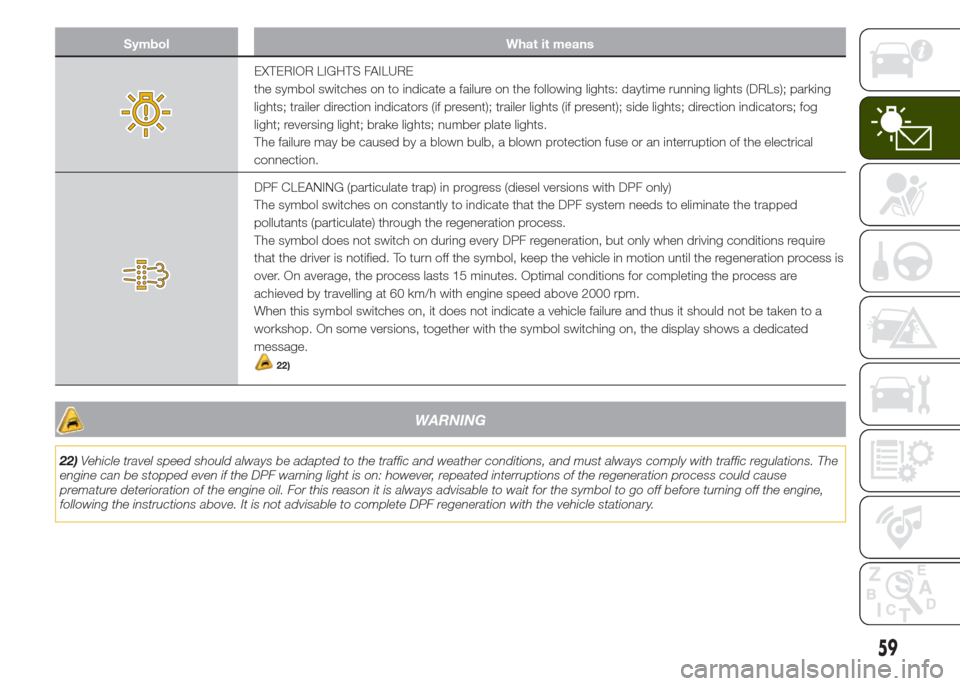
Symbol What it means
EXTERIOR LIGHTS FAILURE
the symbol switches on to indicate a failure on the following lights: daytime running lights (DRLs); parking
lights; trailer direction indicators (if present); trailer lights (if present); side lights; direction indicators; fog
light; reversing light; brake lights; number plate lights.
The failure may be caused by a blown bulb, a blown protection fuse or an interruption of the electrical
connection.
DPF CLEANING (particulate trap) in progress (diesel versions with DPF only)
The symbol switches on constantly to indicate that the DPF system needs to eliminate the trapped
pollutants (particulate) through the regeneration process.
The symbol does not switch on during every DPF regeneration, but only when driving conditions require
that the driver is notified. To turn off the symbol, keep the vehicle in motion until the regeneration process is
over. On average, the process lasts 15 minutes. Optimal conditions for completing the process are
achieved by travelling at 60 km/h with engine speed above 2000 rpm.
When this symbol switches on, it does not indicate a vehicle failure and thus it should not be taken to a
workshop. On some versions, together with the symbol switching on, the display shows a dedicated
message.
22)
WARNING
22)Vehicle travel speed should always be adapted to the traffic and weather conditions, and must always comply with traffic regulations. The
engine can be stopped even if the DPF warning light is on: however, repeated interruptions of the regeneration process could cause
premature deterioration of the engine oil. For this reason it is always advisable to wait for the symbol to go off before turning off the engine,
following the instructions above. It is not advisable to complete DPF regeneration with the vehicle stationary.
59
Page 62 of 212
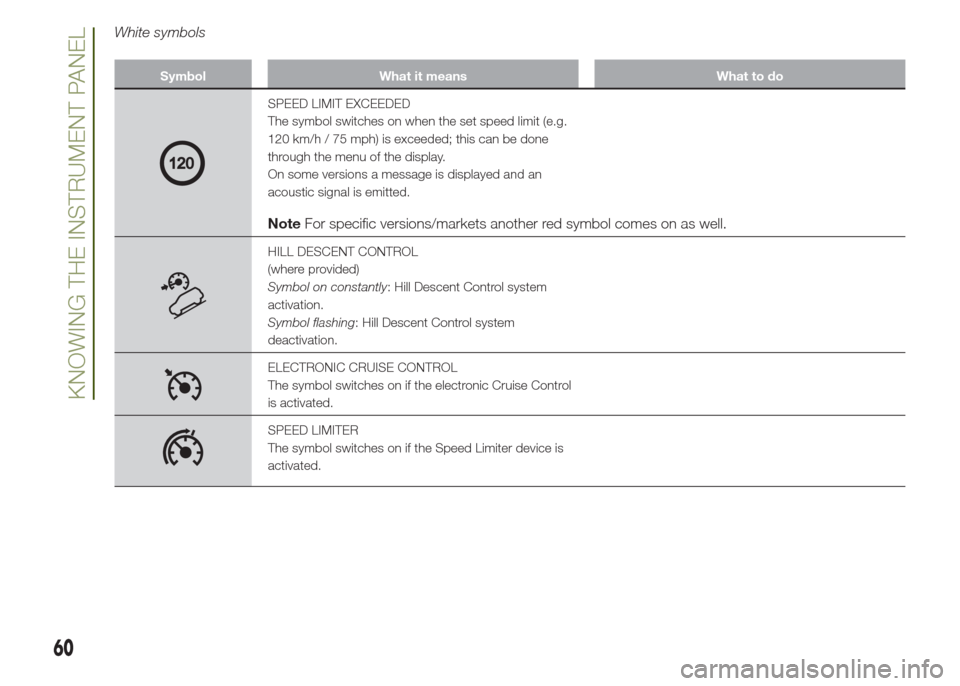
White symbols
Symbol What it means What to do
SPEED LIMIT EXCEEDED
The symbol switches on when the set speed limit (e.g.
120 km/h / 75 mph) is exceeded; this can be done
through the menu of the display.
On some versions a message is displayed and an
acoustic signal is emitted.
NoteFor specific versions/markets another red symbol comes on as well.
HILL DESCENT CONTROL
(where provided)
Symbol on constantly: Hill Descent Control system
activation.
Symbol flashing: Hill Descent Control system
deactivation.
ELECTRONIC CRUISE CONTROL
The symbol switches on if the electronic Cruise Control
is activated.
SPEED LIMITER
The symbol switches on if the Speed Limiter device is
activated.
60
KNOWING THE INSTRUMENT PANEL
Page 63 of 212
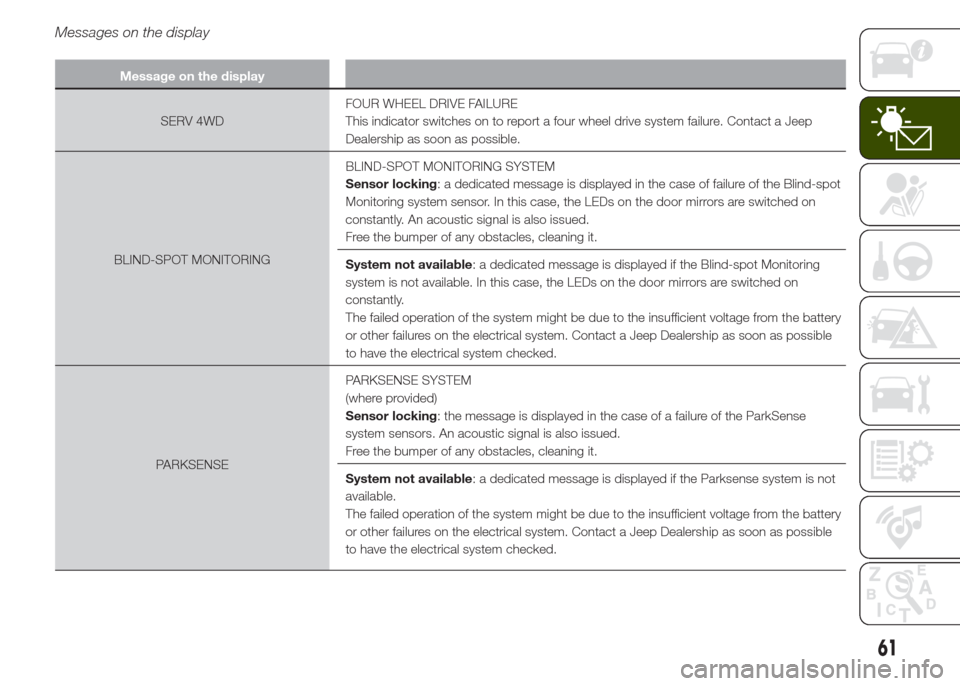
Messages on the display
Message on the display
SERV 4WDFOUR WHEEL DRIVE FAILURE
This indicator switches on to report a four wheel drive system failure. Contact a Jeep
Dealership as soon as possible.
BLIND-SPOT MONITORINGBLIND-SPOT MONITORING SYSTEM
Sensor locking: a dedicated message is displayed in the case of failure of the Blind-spot
Monitoring system sensor. In this case, the LEDs on the door mirrors are switched on
constantly. An acoustic signal is also issued.
Free the bumper of any obstacles, cleaning it.
System not available: a dedicated message is displayed if the Blind-spot Monitoring
system is not available. In this case, the LEDs on the door mirrors are switched on
constantly.
The failed operation of the system might be due to the insufficient voltage from the battery
or other failures on the electrical system. Contact a Jeep Dealership as soon as possible
to have the electrical system checked.
PARKSENSEPARKSENSE SYSTEM
(where provided)
Sensor locking: the message is displayed in the case of a failure of the ParkSense
system sensors. An acoustic signal is also issued.
Free the bumper of any obstacles, cleaning it.
System not available: a dedicated message is displayed if the Parksense system is not
available.
The failed operation of the system might be due to the insufficient voltage from the battery
or other failures on the electrical system. Contact a Jeep Dealership as soon as possible
to have the electrical system checked.
61
Page 64 of 212
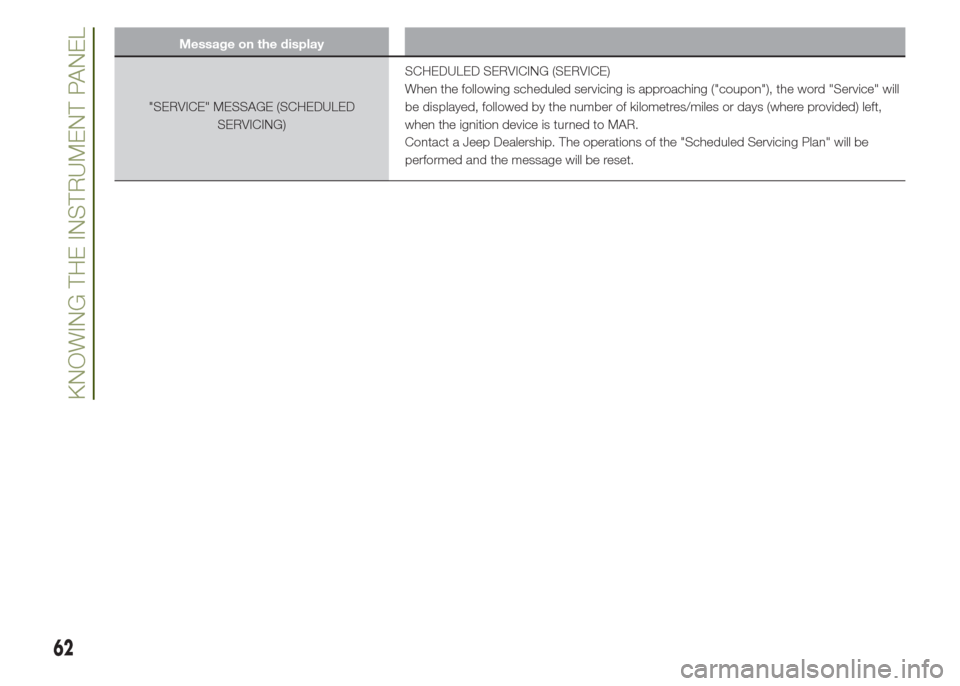
Message on the display
"SERVICE" MESSAGE (SCHEDULED
SERVICING)SCHEDULED SERVICING (SERVICE)
When the following scheduled servicing is approaching ("coupon"), the word "Service" will
be displayed, followed by the number of kilometres/miles or days (where provided) left,
when the ignition device is turned to MAR.
Contact a Jeep Dealership. The operations of the "Scheduled Servicing Plan" will be
performed and the message will be reset.
62
KNOWING THE INSTRUMENT PANEL
Page 65 of 212
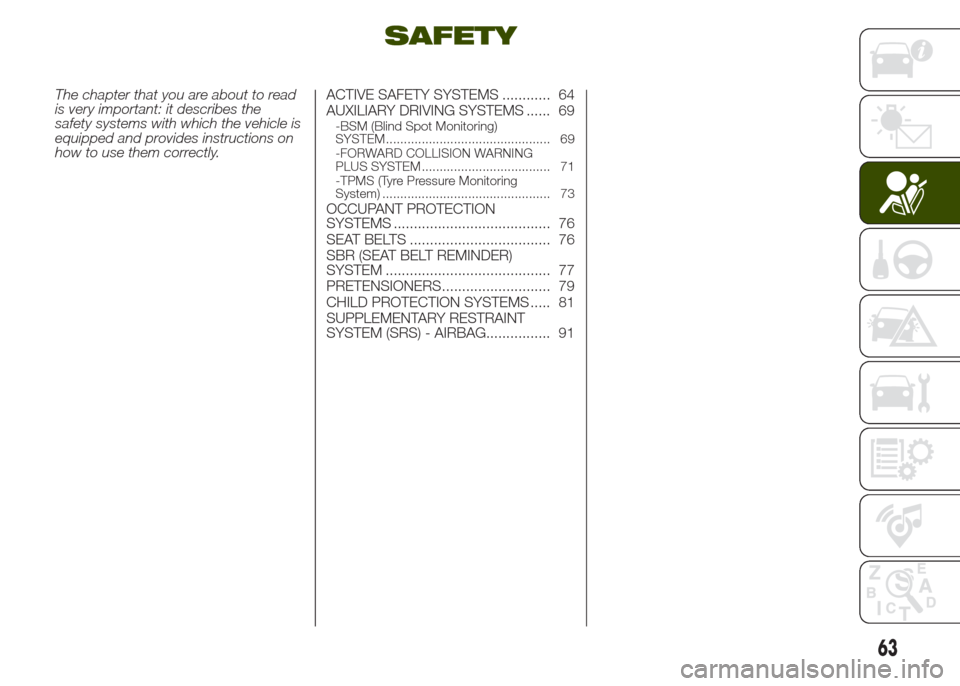
SAFETY
The chapter that you are about to read
is very important: it describes the
safety systems with which the vehicle is
equipped and provides instructions on
how to use them correctly.ACTIVE SAFETY SYSTEMS ............ 64
AUXILIARY DRIVING SYSTEMS ...... 69
-BSM (Blind Spot Monitoring)
SYSTEM.............................................. 69
-FORWARD COLLISION WARNING
PLUS SYSTEM .................................... 71
-TPMS (Tyre Pressure Monitoring
System) ............................................... 73
OCCUPANT PROTECTION
SYSTEMS ....................................... 76
SEAT BELTS ................................... 76
SBR (SEAT BELT REMINDER)
SYSTEM ......................................... 77
PRETENSIONERS........................... 79
CHILD PROTECTION SYSTEMS ..... 81
SUPPLEMENTARY RESTRAINT
SYSTEM (SRS) - AIRBAG................ 91
63
Page 66 of 212
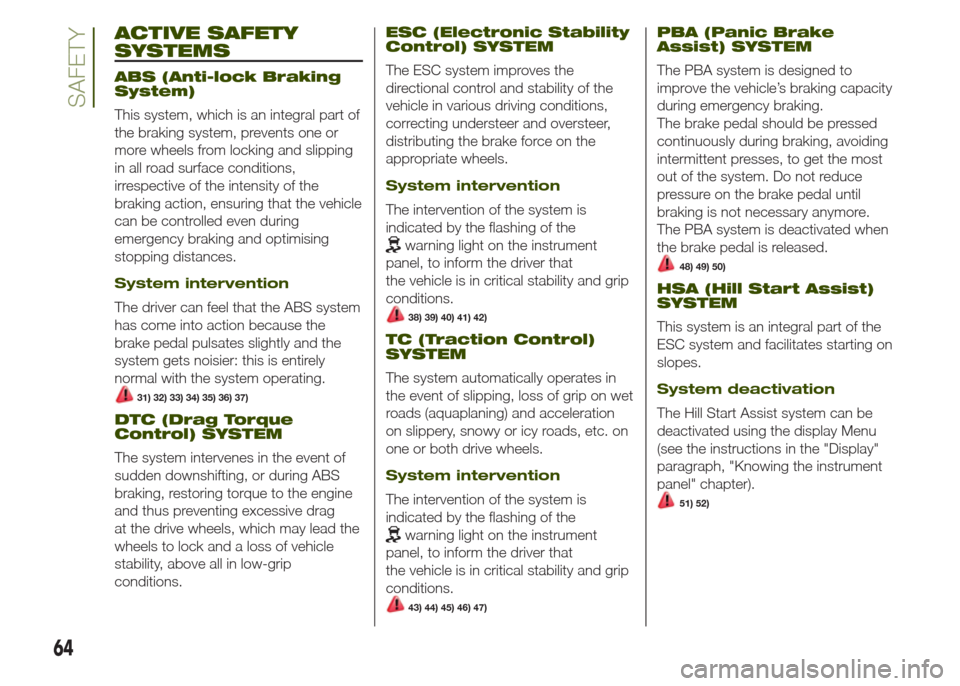
ACTIVE SAFETY
SYSTEMS
ABS (Anti-lock Braking
System)
This system, which is an integral part of
the braking system, prevents one or
more wheels from locking and slipping
in all road surface conditions,
irrespective of the intensity of the
braking action, ensuring that the vehicle
can be controlled even during
emergency braking and optimising
stopping distances.
System intervention
The driver can feel that the ABS system
has come into action because the
brake pedal pulsates slightly and the
system gets noisier: this is entirely
normal with the system operating.
31) 32) 33) 34) 35) 36) 37)
DTC (Drag Torque
Control) SYSTEM
The system intervenes in the event of
sudden downshifting, or during ABS
braking, restoring torque to the engine
and thus preventing excessive drag
at the drive wheels, which may lead the
wheels to lock and a loss of vehicle
stability, above all in low-grip
conditions.
ESC (Electronic Stability
Control) SYSTEM
The ESC system improves the
directional control and stability of the
vehicle in various driving conditions,
correcting understeer and oversteer,
distributing the brake force on the
appropriate wheels.
System intervention
The intervention of the system is
indicated by the flashing of the
warning light on the instrument
panel, to inform the driver that
the vehicle is in critical stability and grip
conditions.
38) 39) 40) 41) 42)
TC (Traction Control)
SYSTEM
The system automatically operates in
the event of slipping, loss of grip on wet
roads (aquaplaning) and acceleration
on slippery, snowy or icy roads, etc. on
one or both drive wheels.
System intervention
The intervention of the system is
indicated by the flashing of the
warning light on the instrument
panel, to inform the driver that
the vehicle is in critical stability and grip
conditions.
43) 44) 45) 46) 47)
PBA (Panic Brake
Assist) SYSTEM
The PBA system is designed to
improve the vehicle’s braking capacity
during emergency braking.
The brake pedal should be pressed
continuously during braking, avoiding
intermittent presses, to get the most
out of the system. Do not reduce
pressure on the brake pedal until
braking is not necessary anymore.
The PBA system is deactivated when
the brake pedal is released.
48) 49) 50)
HSA (Hill Start Assist)
SYSTEM
This system is an integral part of the
ESC system and facilitates starting on
slopes.
System deactivation
The Hill Start Assist system can be
deactivated using the display Menu
(see the instructions in the "Display"
paragraph, "Knowing the instrument
panel" chapter).
51) 52)
64
SAFETY
Page 67 of 212
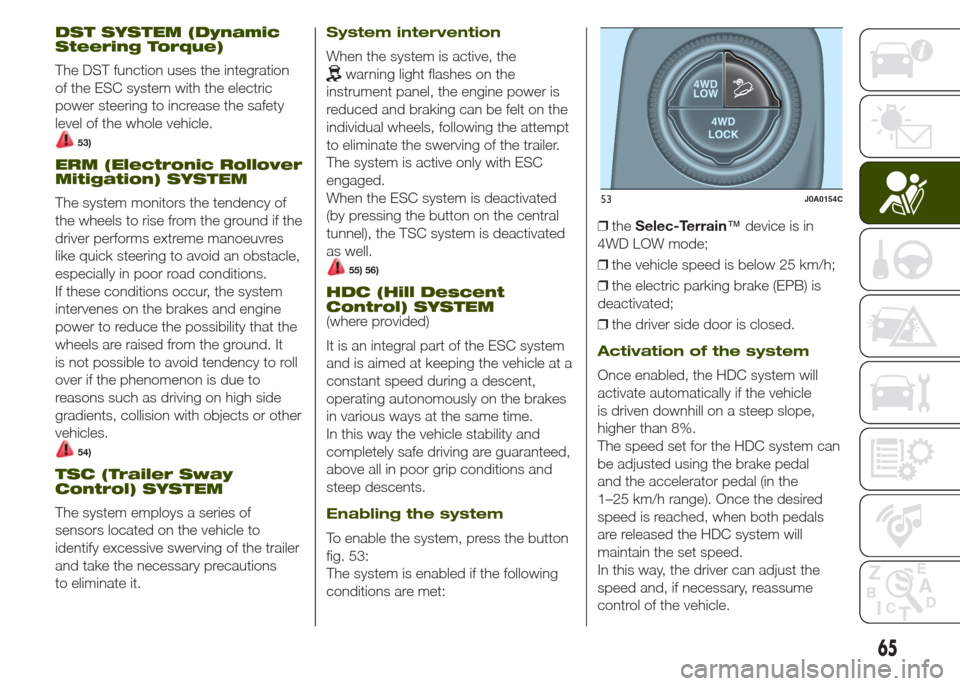
DST SYSTEM (Dynamic
Steering Torque)
The DST function uses the integration
of the ESC system with the electric
power steering to increase the safety
level of the whole vehicle.
53)
ERM (Electronic Rollover
Mitigation) SYSTEM
The system monitors the tendency of
the wheels to rise from the ground if the
driver performs extreme manoeuvres
like quick steering to avoid an obstacle,
especially in poor road conditions.
If these conditions occur, the system
intervenes on the brakes and engine
power to reduce the possibility that the
wheels are raised from the ground. It
is not possible to avoid tendency to roll
over if the phenomenon is due to
reasons such as driving on high side
gradients, collision with objects or other
vehicles.
54)
TSC (Trailer Sway
Control) SYSTEM
The system employs a series of
sensors located on the vehicle to
identify excessive swerving of the trailer
and take the necessary precautions
to eliminate it.
System intervention
When the system is active, the
warning light flashes on the
instrument panel, the engine power is
reduced and braking can be felt on the
individual wheels, following the attempt
to eliminate the swerving of the trailer.
The system is active only with ESC
engaged.
When the ESC system is deactivated
(by pressing the button on the central
tunnel), the TSC system is deactivated
as well.
55) 56)
HDC (Hill Descent
Control) SYSTEM
(where provided)
It is an integral part of the ESC system
and is aimed at keeping the vehicle at a
constant speed during a descent,
operating autonomously on the brakes
in various ways at the same time.
In this way the vehicle stability and
completely safe driving are guaranteed,
above all in poor grip conditions and
steep descents.
Enabling the system
To enable the system, press the button
fig. 53:
The system is enabled if the following
conditions are met:❒theSelec-Terrain™device is in
4WD LOW mode;
❒the vehicle speed is below 25 km/h;
❒the electric parking brake (EPB) is
deactivated;
❒the driver side door is closed.
Activation of the system
Once enabled, the HDC system will
activate automatically if the vehicle
is driven downhill on a steep slope,
higher than 8%.
The speed set for the HDC system can
be adjusted using the brake pedal
and the accelerator pedal (in the
1–25 km/h range). Once the desired
speed is reached, when both pedals
are released the HDC system will
maintain the set speed.
In this way, the driver can adjust the
speed and, if necessary, reassume
control of the vehicle.
53J0A0154C
65
Page 68 of 212
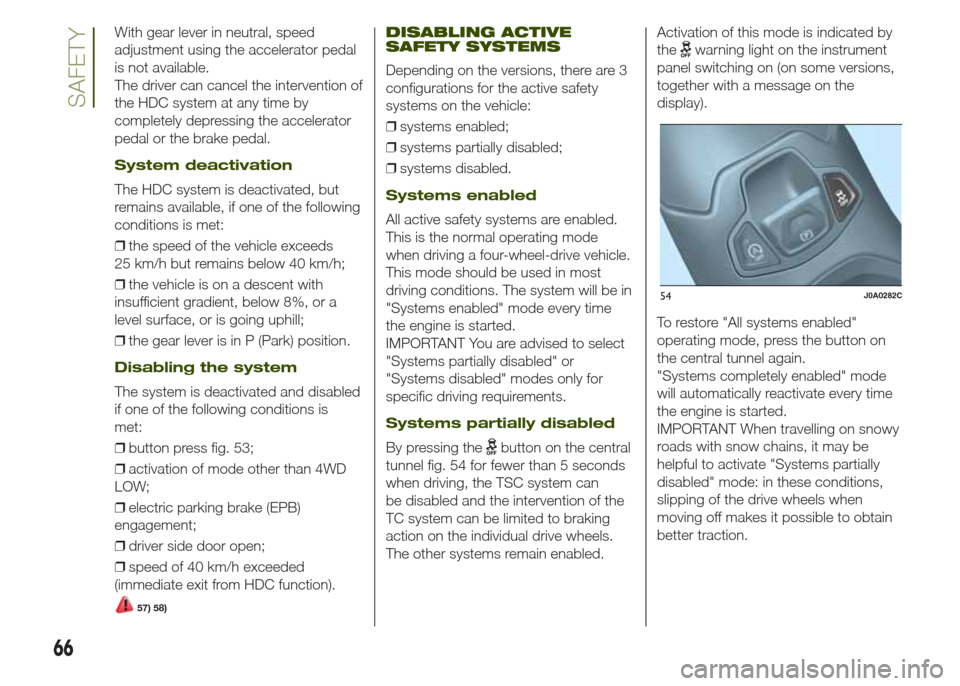
With gear lever in neutral, speed
adjustment using the accelerator pedal
is not available.
The driver can cancel the intervention of
the HDC system at any time by
completely depressing the accelerator
pedal or the brake pedal.
System deactivation
The HDC system is deactivated, but
remains available, if one of the following
conditions is met:
❒the speed of the vehicle exceeds
25 km/h but remains below 40 km/h;
❒the vehicle is on a descent with
insufficient gradient, below 8%, or a
level surface, or is going uphill;
❒the gear lever is in P (Park) position.
Disabling the system
The system is deactivated and disabled
if one of the following conditions is
met:
❒button press fig. 53;
❒activation of mode other than 4WD
LOW;
❒electric parking brake (EPB)
engagement;
❒driver side door open;
❒speed of 40 km/h exceeded
(immediate exit from HDC function).
57) 58)
DISABLING ACTIVE
SAFETY SYSTEMS
Depending on the versions, there are 3
configurations for the active safety
systems on the vehicle:
❒systems enabled;
❒systems partially disabled;
❒systems disabled.
Systems enabled
All active safety systems are enabled.
This is the normal operating mode
when driving a four-wheel-drive vehicle.
This mode should be used in most
driving conditions. The system will be in
"Systems enabled" mode every time
the engine is started.
IMPORTANT You are advised to select
"Systems partially disabled" or
"Systems disabled" modes only for
specific driving requirements.
Systems partially disabled
By pressing thebutton on the central
tunnel fig. 54 for fewer than 5 seconds
when driving, the TSC system can
be disabled and the intervention of the
TC system can be limited to braking
action on the individual drive wheels.
The other systems remain enabled.Activation of this mode is indicated by
the
warning light on the instrument
panel switching on (on some versions,
together with a message on the
display).
To restore "All systems enabled"
operating mode, press the button on
the central tunnel again.
"Systems completely enabled" mode
will automatically reactivate every time
the engine is started.
IMPORTANT When travelling on snowy
roads with snow chains, it may be
helpful to activate "Systems partially
disabled" mode: in these conditions,
slipping of the drive wheels when
moving off makes it possible to obtain
better traction.
54J0A0282C
66
SAFETY
Page 69 of 212
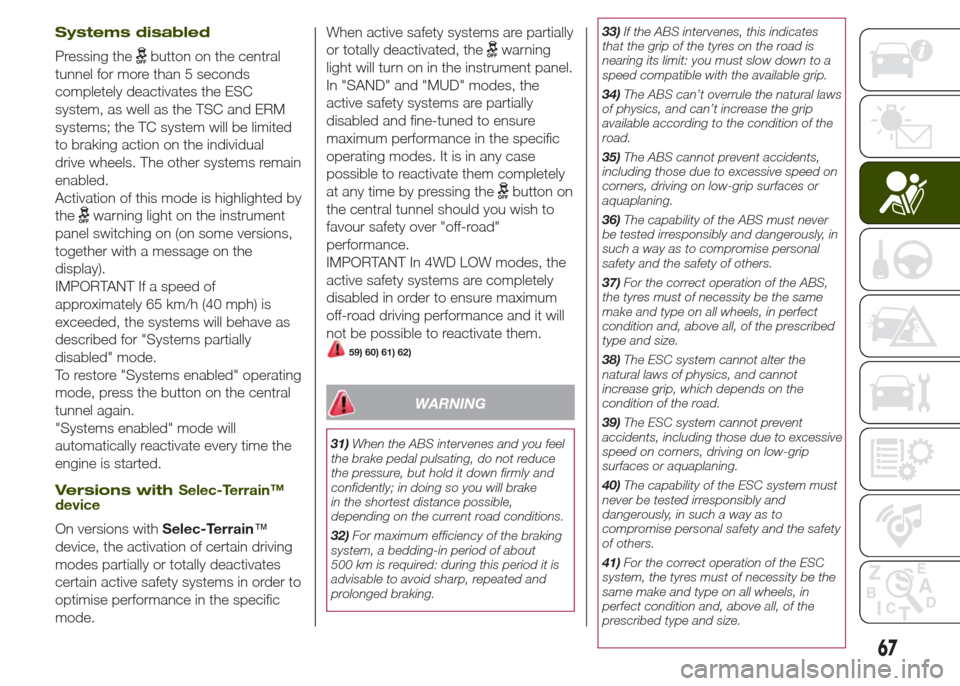
Systems disabled
Pressing thebutton on the central
tunnel for more than 5 seconds
completely deactivates the ESC
system, as well as the TSC and ERM
systems; the TC system will be limited
to braking action on the individual
drive wheels. The other systems remain
enabled.
Activation of this mode is highlighted by
the
warning light on the instrument
panel switching on (on some versions,
together with a message on the
display).
IMPORTANT If a speed of
approximately 65 km/h (40 mph) is
exceeded, the systems will behave as
described for "Systems partially
disabled" mode.
To restore "Systems enabled" operating
mode, press the button on the central
tunnel again.
"Systems enabled" mode will
automatically reactivate every time the
engine is started.
Versions withSelec-Terrain™
device
On versions withSelec-Terrain™
device, the activation of certain driving
modes partially or totally deactivates
certain active safety systems in order to
optimise performance in the specific
mode.When active safety systems are partially
or totally deactivated, the
warning
light will turn on in the instrument panel.
In "SAND" and "MUD" modes, the
active safety systems are partially
disabled and fine-tuned to ensure
maximum performance in the specific
operating modes. It is in any case
possible to reactivate them completely
at any time by pressing the
button on
the central tunnel should you wish to
favour safety over "off-road"
performance.
IMPORTANT In 4WD LOW modes, the
active safety systems are completely
disabled in order to ensure maximum
off-road driving performance and it will
not be possible to reactivate them.
59) 60) 61) 62)
WARNING
31)When the ABS intervenes and you feel
the brake pedal pulsating, do not reduce
the pressure, but hold it down firmly and
confidently; in doing so you will brake
in the shortest distance possible,
depending on the current road conditions.
32)For maximum efficiency of the braking
system, a bedding-in period of about
500 km is required: during this period it is
advisable to avoid sharp, repeated and
prolonged braking.33)If the ABS intervenes, this indicates
that the grip of the tyres on the road is
nearing its limit: you must slow down to a
speed compatible with the available grip.
34)The ABS can’t overrule the natural laws
of physics, and can’t increase the grip
available according to the condition of the
road.
35)The ABS cannot prevent accidents,
including those due to excessive speed on
corners, driving on low-grip surfaces or
aquaplaning.
36)The capability of the ABS must never
be tested irresponsibly and dangerously, in
such a way as to compromise personal
safety and the safety of others.
37)For the correct operation of the ABS,
the tyres must of necessity be the same
make and type on all wheels, in perfect
condition and, above all, of the prescribed
type and size.
38)The ESC system cannot alter the
natural laws of physics, and cannot
increase grip, which depends on the
condition of the road.
39)The ESC system cannot prevent
accidents, including those due to excessive
speed on corners, driving on low-grip
surfaces or aquaplaning.
40)The capability of the ESC system must
never be tested irresponsibly and
dangerously, in such a way as to
compromise personal safety and the safety
of others.
41)For the correct operation of the ESC
system, the tyres must of necessity be the
same make and type on all wheels, in
perfect condition and, above all, of the
prescribed type and size.
67
Page 70 of 212
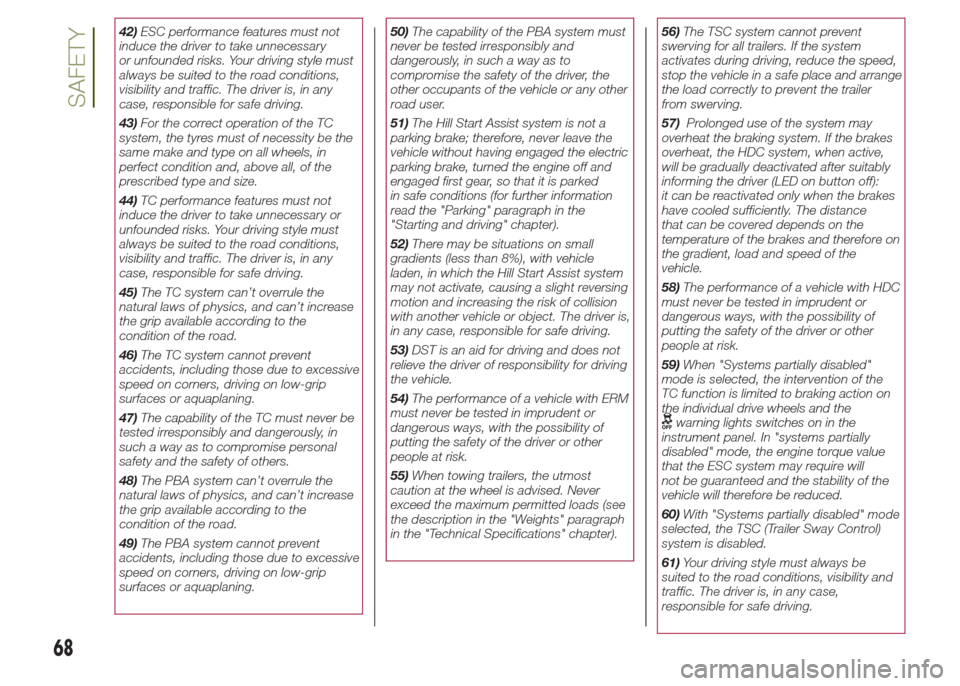
42)ESC performance features must not
induce the driver to take unnecessary
or unfounded risks. Your driving style must
always be suited to the road conditions,
visibility and traffic. The driver is, in any
case, responsible for safe driving.
43)For the correct operation of the TC
system, the tyres must of necessity be the
same make and type on all wheels, in
perfect condition and, above all, of the
prescribed type and size.
44)TC performance features must not
induce the driver to take unnecessary or
unfounded risks. Your driving style must
always be suited to the road conditions,
visibility and traffic. The driver is, in any
case, responsible for safe driving.
45)The TC system can’t overrule the
natural laws of physics, and can’t increase
the grip available according to the
condition of the road.
46)The TC system cannot prevent
accidents, including those due to excessive
speed on corners, driving on low-grip
surfaces or aquaplaning.
47)The capability of the TC must never be
tested irresponsibly and dangerously, in
such a way as to compromise personal
safety and the safety of others.
48)The PBA system can’t overrule the
natural laws of physics, and can’t increase
the grip available according to the
condition of the road.
49)The PBA system cannot prevent
accidents, including those due to excessive
speed on corners, driving on low-grip
surfaces or aquaplaning.50)The capability of the PBA system must
never be tested irresponsibly and
dangerously, in such a way as to
compromise the safety of the driver, the
other occupants of the vehicle or any other
road user.
51)The Hill Start Assist system is not a
parking brake; therefore, never leave the
vehicle without having engaged the electric
parking brake, turned the engine off and
engaged first gear, so that it is parked
in safe conditions (for further information
read the "Parking" paragraph in the
"Starting and driving" chapter).
52)There may be situations on small
gradients (less than 8%), with vehicle
laden, in which the Hill Start Assist system
may not activate, causing a slight reversing
motion and increasing the risk of collision
with another vehicle or object. The driver is,
in any case, responsible for safe driving.
53)DST is an aid for driving and does not
relieve the driver of responsibility for driving
the vehicle.
54)The performance of a vehicle with ERM
must never be tested in imprudent or
dangerous ways, with the possibility of
putting the safety of the driver or other
people at risk.
55)When towing trailers, the utmost
caution at the wheel is advised. Never
exceed the maximum permitted loads (see
the description in the "Weights" paragraph
in the "Technical Specifications" chapter).56)The TSC system cannot prevent
swerving for all trailers. If the system
activates during driving, reduce the speed,
stop the vehicle in a safe place and arrange
the load correctly to prevent the trailer
from swerving.
57)Prolonged use of the system may
overheat the braking system. If the brakes
overheat, the HDC system, when active,
will be gradually deactivated after suitably
informing the driver (LED on button off):
it can be reactivated only when the brakes
have cooled sufficiently. The distance
that can be covered depends on the
temperature of the brakes and therefore on
the gradient, load and speed of the
vehicle.
58)The performance of a vehicle with HDC
must never be tested in imprudent or
dangerous ways, with the possibility of
putting the safety of the driver or other
people at risk.
59)When "Systems partially disabled"
mode is selected, the intervention of the
TC function is limited to braking action on
the individual drive wheels and the
warning lights switches on in the
instrument panel. In "systems partially
disabled" mode, the engine torque value
that the ESC system may require will
not be guaranteed and the stability of the
vehicle will therefore be reduced.
60)With "Systems partially disabled" mode
selected, the TSC (Trailer Sway Control)
system is disabled.
61)Your driving style must always be
suited to the road conditions, visibility and
traffic. The driver is, in any case,
responsible for safe driving.
68
SAFETY